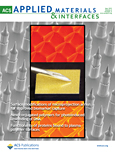 Universidade de Franca, Av. Dr. Armando Salles Oliveira, 201 - Pq. Universitario, 14404-600 Franca, SP, Brazil, Departamento de Química Inorgánica, Facultad de Ciencias Químicas, Plaza de la Merced, Universidad de Salamanca, E-37008-Salamanca, Spain, and Departamento de Química Aplicada, Edificio de los Acebos, Campus de Arrosadía, Universidad Pública de Navarra, E-31006-Pamplona, Spain
Universidade de Franca, Av. Dr. Armando Salles Oliveira, 201 - Pq. Universitario, 14404-600 Franca, SP, Brazil, Departamento de Química Inorgánica, Facultad de Ciencias Químicas, Plaza de la Merced, Universidad de Salamanca, E-37008-Salamanca, Spain, and Departamento de Química Aplicada, Edificio de los Acebos, Campus de Arrosadía, Universidad Pública de Navarra, E-31006-Pamplona, Spain
J. Chem. Eng. Data, 2009, 54 (2), pp 241–247
DOI: 10.1021/je800221a
* Corresponding author. E-mail: ciuffi@unifran.br., †
Part of the special issue “Robin H. Stokes Festschrift”.
, ‡Universidade de Franca.
, §Universidad de Salamanca.
,Universidad Pública de Navarra.
Section: Abstract
Abstract
This work reports on the application of a takovite−aluminosilicate nanocomposite, synthesized by a coprecipitation procedure, as adsorbent for the removal of Cr(III) and Pb(II) from aqueous solutions. Experimental studies to determine the maximum fixation capacities, the adsorption isotherms, and the affinity order of the adsorption process were carried out. The sorption of Pb(II) ions is fast, and the equilibrium is reached within 20 min, while 180 min is necessary for the equilibrium to be reached in the case of Cr(III) ions. The adsorption kinetics of cations has been studied in terms of pseudofirst-order and pseudosecond-order kinetics. The Freundlich and Sips isotherm models have also been applied to the equilibrium adsorption data. The takovite−aluminosilicate nanocomposite material has excellent textural properties and can be used as an efficient adsorbent of Cr(III) and Pb(II) cations.
Citing Articles
Citation data is made available by participants in CrossRef's Cited-by Linking service. For a more comprehensive list of citations to this article, users are encouraged to perform a search in SciFinder.







